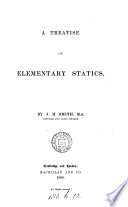 | James Hamblin Smith - Statics - 1868 - 102 pages
...:: sin ONF : sin NME : sin MOD :: sin a : sin yS : sin 7. 23. THE POLYGON OF FORCES. If any number of forces acting at a point can be represented in magnitude and direction by the sides of a polygon taken in order, they will be in equilibrium. Let the forces acting at A be represented in magnitude... | |
 | Richard Wormell - Mechanics - 1869 - 270 pages
...construction we may at once deduce the following proposition. When a number of forces acting on a particle can be represented in magnitude and direction by the sides of a polygon taken in order the forces are in equilibrium. Parallelepiped of Forces. 34. If three forces,... | |
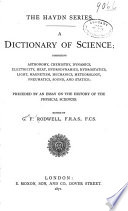 | George Farrer Rodwell - Physical sciences - 1871 - 620 pages
...side completing the polygon. From this it follows that when a number of forces acting upon a particle can be represented in magnitude and direction by the...polygon taken in order, the forces are in equilibrium. (See ParaUeloyram of forces, Trianyle of Forces.) POLYZONAL LENS. Sir David Brewster constructed »... | |
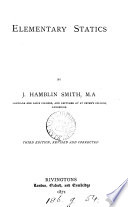 | James Hamblin Smith - Statics - 1871 - 148 pages
...sin NME: sin MOD, (Trig. Art. 101), sin a : sin /3 : sin y. 40. THE POLYGON OF FORCES. If any number of forces, acting at a point, can be represented in magnitude and direction by the sides of a polygon taken in order, they will be in equilibrium. Let any number of forces P, Q, R, S, T, acting... | |
 | Charles Robert Cross - Mechanics - 1873 - 182 pages
...resultant of all but one of them must evidently be equal and opposite to the remaining force. 88. If the forces acting at a point can be represented in magnitude and direction by the sides of a polygon taken in order, they will be in equilibrium. For by a course of reasoning similar to that used... | |
 | J Alfred Skertchly - 1873 - 184 pages
...other forces. Also : — Whenever any number of forces, acting on a point, are so disposed that they can be represented in. magnitude and direction by the sides of a polygon, or other geometrical figure, taken in order, the forces are in equilibrium. Hence it follows... | |
 | University of Madras - 1874 - 502 pages
...their resultant. Prove this for parallel forces. III. If any number of forces acting through the same point can be represented in magnitude and direction by the sides of a closed polygon taken in order, those forces balance each other. IV. A block of wood weighing 200 Ibs. rests On a plank inclined to... | |
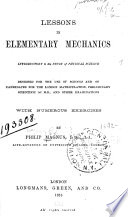 | Sir Philip Magnus - Mechanics - 1875 - 352 pages
...would have remained at rest. If, therefore, the several velocities, with which the body tends to move, can be represented in magnitude and direction by the sides of a closed polygon taken in order, the body will be at rest; but if the velocities are represented by the sides of an open polygon, the body... | |
 | sir Philip Magnus (1st bart.) - Mechanics - 1876 - 368 pages
...would have remained at rest. If, therefore, the several velocities, with which the body tends to move, can be represented in magnitude and direction by the sides of a closed polygon taken in order, the body will be at rest ; but if the velocities are represented by the sides of an open polygon, the body... | |
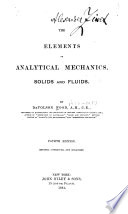 | De Volson Wood - Mechanics, Analytic - 1876 - 500 pages
...opposite, we have F = P ein P,R sin f$B R sn (iS) POLYGON OF FOHCES. 45. If several ioncurrent forces are represented in magnitude and direction by the sides of a closed polygon taken in their order, they mill be in equilibrium. This may be proved by finding the resultant of two forces... | |
| |